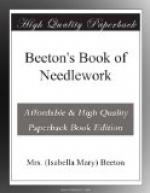210 and 211.—Medallions in Point Russe.
Materials: Coloured filoselle, cloth, velvet, cashmere, or silk.
These medallions can be alternated for ornamenting small covers, cushions, borders, &c. They are worked with coloured filoselle in point Russe, herring-bone stitch, coral stitch, and knotted stitch, on cloth, velvet, cashmere, or silk. The middle oval of both medallions contrasts with the colour of the ground, and must therefore be worked in applique on the latter with herring-bone stitch, before working the outer border. The wreath on No. 211 is worked in coral stitch; the knots, which imitate small blossoms, in knotted stitch. The choice of colours is left to the personal taste of the worker.
[Illustration: 210.—Medallion in Point Russe.]
[Illustration: 211.—Medallion in Point Russe.]
* * * * *
212.—Butterfly for Handkerchief Corner.
Materials: French lawn or cambric; fine black silk.
This butterfly is worked in the finest black silk procurable, in order more closely to imitate etching. It is worked in point Russe and scallop stitch; the dark shaded scallops are worked in button-hole scallop stitch, the stitches being taken very closely together, but not raised by the usual method of placing chain stitches beneath the button-hole stitches. The outlines and flowers are worked in point Russe, the dot in knotted stitch (see No. 73, Embroidery Instructions.)
[Illustration: 212.—Butterfly for Handkerchief Corner.]
The initials are embroidered in raised slanting overcast stitch, and should be worked with great regularity.
* * * * *
213 to 215.—Pattern for a Couvrette in Applique. (see pages 576-7.)
Materials: Messrs. Walter Evans and Co.’s embroidery cotton Nos. 24 and 30; cambric muslin; Brussels net; flesh-coloured silk; sewing silk of the same shade; 1 skein of a darker shade; blue silk; brown silk; gold thread.
This style of work is most effective for couvrettes or bed covers. It is worked in cambric muslin and silk, over Brussels net.
The arabesque patterns are worked in cambric muslin, the outlines are embroidered in overcast, and the material is cut away all round. The medallions are made of blue silk; the figures upon them are cut out of flesh-coloured silk, and are gummed first upon tissue-paper, then upon the blue silk; the figures are further fastened upon the medallions in overcast stitch with fine silk of a rather darker shade of flesh-colour. The scarfs are cut out of bright rose-coloured silk; the quiver and arrows and all the other attributes are worked in gold thread; the hair in fine brown silk. The edge of the blue silk medallions is worked round in button-hole stitch, but so as to be easily unripped when the couvrette has to be cleaned. A border in open ladder stitch is worked round them (see No. 81, Embroidery Instructions). The openings in the centre pattern are also filled in with lace stitches.




